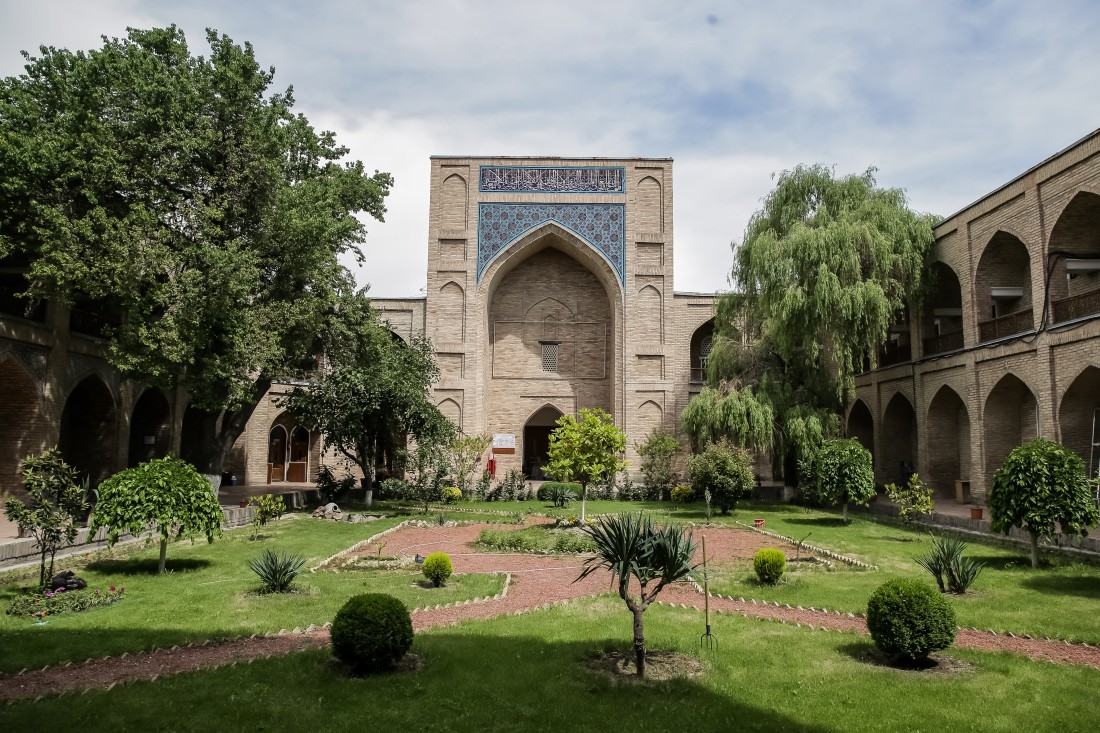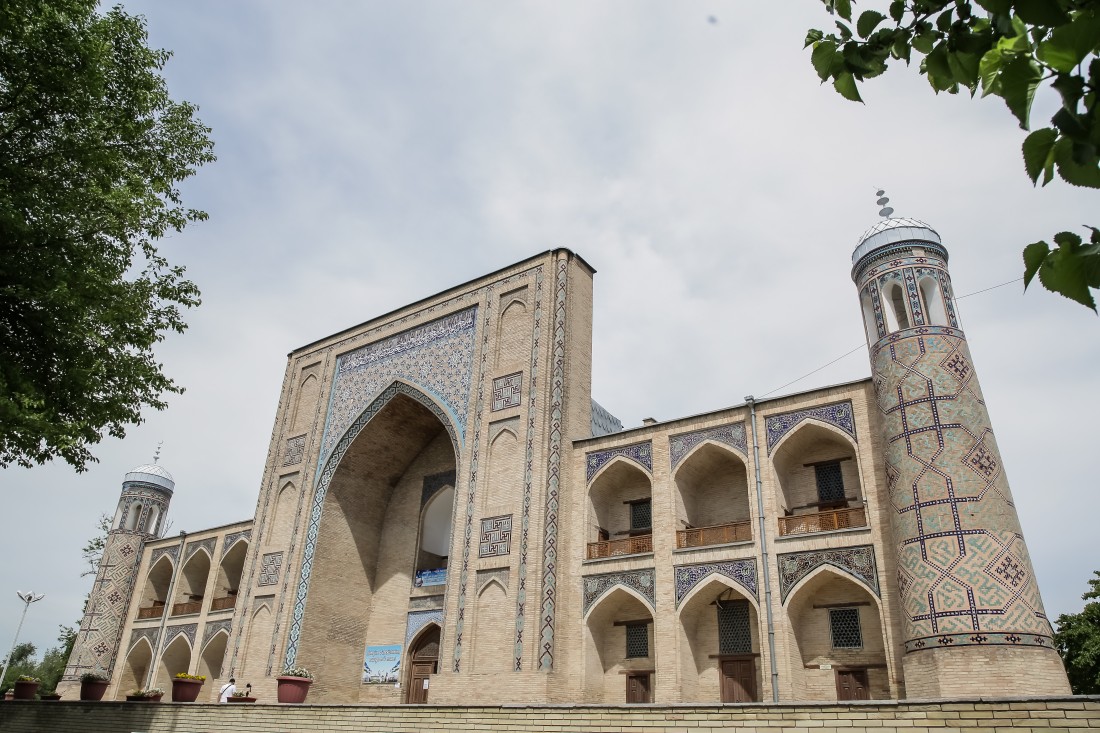The Chorsu district of modern Tashkent is a crossroads of the main streets. Kukeldash Madrasah rises above the elevated edge of the old city wall; to the right of the ancient buildings remains, a new Khoja Akhror Vali mosque was built.

The old madrasah and the mosque of Khoja Akhror were located here till 1954. The majestic volumes of these religious buildings dominated the silhouette of an inexpressive urban area. The actual city Shakhristan, with its bazaars, shops, houses of merchants and workshops of artisans, was located here.
Khoja Akhror mosque was once one of the earliest Islamic buildings in the city. The first building of Tashkent, “Juma” mosque, the main Friday mosque, was built in 1451 at the expense of Sheikh Ubaidulla Khoja Akhror (1404-1490).
Ubaidullah Akhror, a well-known Sufi, leader of the Muslim clergy and a descendant of the Prophet Mukhammad, preparing to move, ordered the construction of a large Friday mosque and madrasah in the ancient Tashkent Gulbazar makhalla (traditional neighborhood). According to the local legends, the funds for the construction were obtained by Ubaidulla from the sale of “thread-scraps” that remained after cutting the fabric into standard pieces.
The Juma mosque served as the basis of the Registan ensemble in the area of Chorsu square. It is the only Tashkent sample of the Friday mosque of the courtyard type, common in Central Asia in the late middle ages. This Juma mosque was the oldest of 157 mosques in the modern Tashkent.
The main building of the old mosque had the shape of a cube, covered by a dome with four windows in a low cylinder. The large arch was cut through on the eastern wall facing the courtyard. The mosque had an elongated rectangular courtyard surrounded by galleries on pillars.
In 1868, the mosque was badly damaged by a devastating earthquake. After 20 years, it was finally restored with funds (17 thousand rubles) allocated from the state treasury by Alexander III. That is why it was called “royal”.
Political events, such as the Russian invasion and the Soviet atheistic regime, led to the complete destruction of the mosque. The ruins were finally demolished in 1997.
Repair work and rebuilding of the Khoja Akhror Vali mosque began in the 90s of the last century. The building was completely rebuilt by modern architects, the cube was demolished, and instead of one dome, now the mosque is crowned with three ones.
In the middle of the XVI century, south-west of the mosque the Kukeldash madrasah was built. It is believed that it was built in 1551-1575 by the vizier of the Tashkent khans Barak-khan and his son Darvish Mukhammad, Kukeldash, which meant “Khan’s milk brother”.
The surviving waqf certificate of Darvish Khan is bequeathed the caravanserai in favor of the madrasah, which indicates the existence of the finished building at that time. There is a mosque at the entrance on the left, behind the portal, and on the right there are audiences covered by domes. The courtyard is spacious, surrounded by 38 hujras around the perimeter and connected with the audiences, the mosque and open aivans. In its scale and abundance of artistic claddings made of majolica and mosaics, the building could compete with the best buildings of Samarkand and Bukhara of that period.
However, time, economic crises, earthquakes at one time greatly changed the appearance of the building.
In the XVII century, Kukeldash madrasah was used as a barn or caravanserai. As a result of the earthquakes of 1886 and 1946, it was badly damaged, and numerous restorations changed its appearance. The top of the entrance portal collapsed to the bottom of the arch. Thanks to the builders, it was possible to literally restore the madrasah from the ruins.
The main twenty-meter high portal of the madrasah has been also restored. The external portal is decorated with majolica of traditional colors – turquoise, blue, white and ocher tones. Nowadays, this functioning madrasah looks elegant and well-groomed. More than one hundred students study there. They enter here on a competitive basis. They have training facilities, a computer room, a library, a calligraphy room, a sports room, a dining room at their disposal, and there is a hostel for visitors.
Many teachers themselves once studied in this madrasah. The study period is 4 years. At the end of the educational process, graduates are distributed in mosques of Uzbekistan. It is also possible to continue the study at any of the country’s higher educational institutions.
Working hours: 9:00 AM - 6:00 PM, Mon-Fri
For any questions
ПОЛЬЗОВАТЕЛЬСКОЕ СОГЛАШЕНИЕ
1. Определение
Настоящее Пользовательское соглашение (далее — Соглашение) является Публичной офертой в соответствии со статьёй 367 Гражданского кодекса Республики Узбекистан от 21.12.1995 (https://lex.uz/ru/docs/111181#162763) и регулирует порядок использования материалов и Сервисов сайта Государственного унитарного предприятия «Национальный PR-центр» (далее — Предприятие), размещённого на веб-сайте и поддоменах Национального Туристического Информационного Центра: https://uzbekistan.travel/ (далее — Сайт).
Посетитель и (или) Пользователь подтверждает, что ознакомлен, полностью и безоговорочно принимает все условия настоящего Соглашения и обязуется их соблюдать.
Использование Сайта Пользователем означает полное принятие данного Соглашения «как есть» в форме акцепта.
Соглашение вступает в силу с момента посещения любой страницы Сайта и (или) регистрации на Сайте и действует бессрочно во время пользования Сервисами Сайта.
Настоящее Соглашение обязательно для исполнения всеми Посетителями и Пользователями без каких-либо изъятий и дополнительных согласований.
Пользователь обязуется самостоятельно проверять актуальную редакцию Соглашения на Сайте перед использованием Сервисов.
2. Предмет Соглашения
Предметом настоящего Соглашения являются правила использования материалов Сайта и предоставление Посетителю и (или) Пользователю возможности использования Сервисов Сайта.
Предприятие является правообладателем исключительных прав на Сайт в целом и на его составные части, включая все виды контента: логотипы, товарные знаки, тексты, статьи, аннотации, иллюстрации, фотографии, графику, аудио- и видеофайлы, пользовательские интерфейсы, дизайн, структуру, программы, базы данных.
Я прочитал(а) и соглашаюсь с условиями использования сайта и политикой конфиденциальности.
